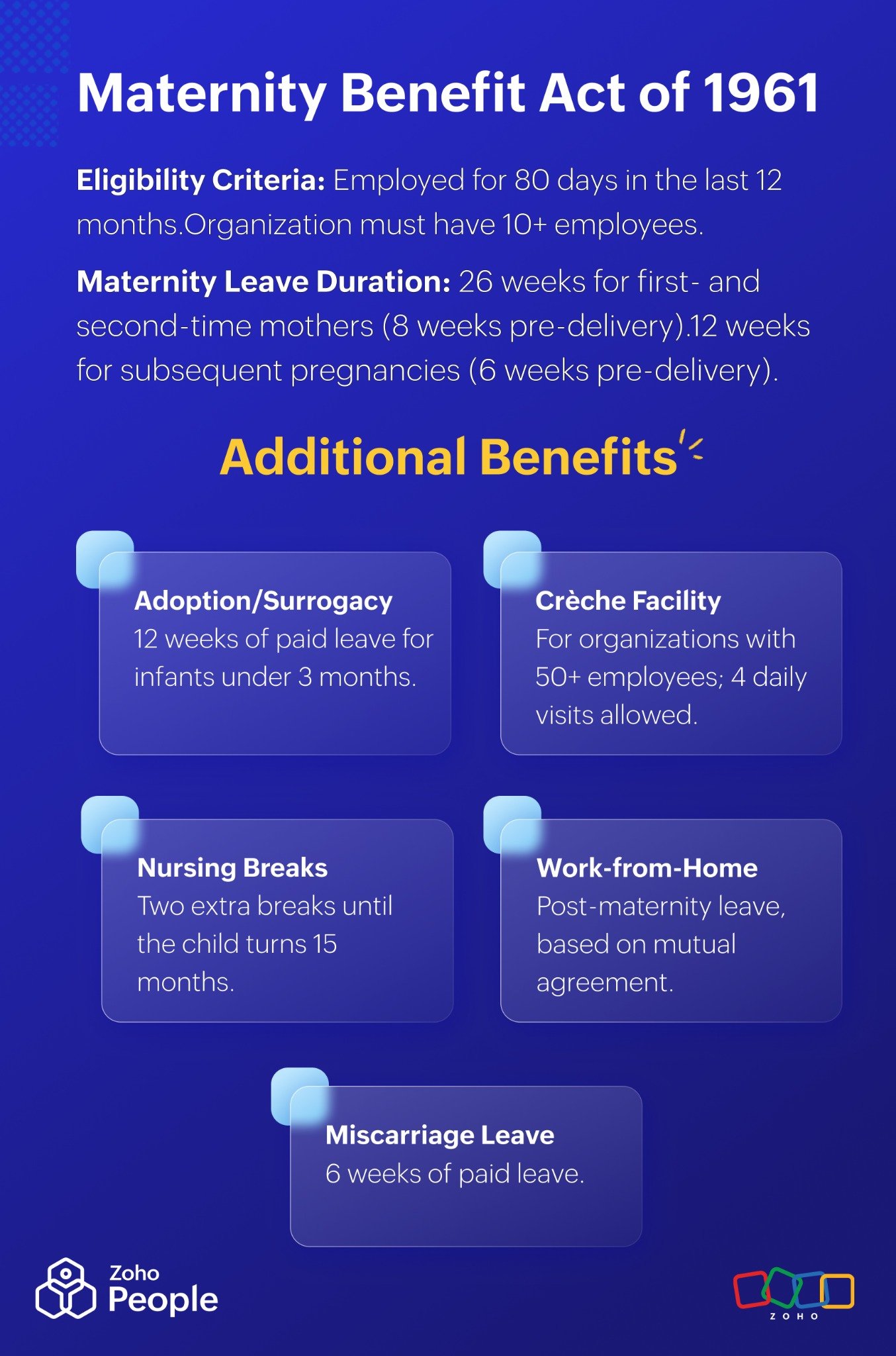- HOME
- HR insights
- Decoding the Maternity Benefit Act: Background, key provisions, and obligations
Decoding the Maternity Benefit Act: Background, key provisions, and obligations
- Last Updated : September 16, 2025
- 1.1K Views
- 4 Min Read

The Maternity Benefit Act in India plays a crucial role in shaping a supportive and inclusive workplace for women. By ensuring essential support during and after childbirth, it empowers female employees to recover and fulfill their maternal duties while maintaining their professional responsibilities seamlessly. This act is a crucial step toward workplace equality and fostering a culture of care. In this blog, we’ll decode the key aspects of the Maternity Benefit Act.
Background
The Maternity Benefit Act of 1961 regulates the maternity leave and employment practices of working women employed in both private and public organizations during and after their delivery. After the independence of India, there was a need for a centralized mandate to regularize the maternity benefits offered to women since most of the states had varied acts and regulations specific to them. Using the International Labor Organization's Maternity Protection Convention 103 as inspiration, the Maternity Benefit Act of 1961 was developed to benefit working women.

Key provisions
Eligibility criteria for maternity leave
According to the Maternity Benefit Act of 1961, female employees need to be employed in their organization for at least 80 days before their expected delivery date in the last twelve months. The organization should employ more than 10 employees.
Duration of maternity leave
For first- and second-time mothers, the duration of maternity leave is usually 26 weeks. For women seeking maternity leave after having two children, the duration of leave is usually 12 weeks. In the first case, they can take leave eight weeks before their expected delivery date, and, in the latter case, they can take leave six weeks before their expected delivery date.
Some other benefits
Miscarriage provisions
When a female employee faces miscarriage or has to terminate a pregnancy due to medical reasons, they'll be entitled to receive six weeks of paid leave. During this, the Maternity Benefit Act prohibits employers from engaging them in tedious tasks.
Leave for adoption and surrogacy
Women employees who adopt infants younger than three months and mothers who receive children through surrogacy are eligible for 12 weeks of fully paid leave.
Nursing breaks for returning mothers
According to the act, after six months of paid leave, when the female employee returns to work, they're entitled to receive two nursing breaks during their working hours in addition to their usual break times. This is applicable until their child is 15 months old.
Work-from-home provisions
According to the 2017 Amendment of the Maternity Benefit Act of 1961, based on a mutual agreement, employers can allow employees who return from maternity leave to work from home.
Crèche facility
The 2017 Amendment also states that employers with 50 or more employees should offer a crèche facility within a short distance from their organization. Women employees should be permitted to visit their children in the crèche facility up to four times a day.
Employer obligations
Here's a list of some key responsibilities expected from employers according to the Maternity Benefit Act of 1961:
Salary during maternity leave
It's an employer's duty to ensure that female employees on maternity leave receive their complete salary all throughout their leave. The salary that the employee was receiving three months before their maternity leave is taken as their average for calculation. If the organization doesn't offer free medical benefits, they're mandated to pay 3,500 rupees as a medical bonus to employees taking maternity leave.
Prohibition of termination
Employers are not allowed to terminate employees while they're on maternity leave, and the terms of their employment must remain unchanged during this time.
Fostering a supportive workplace
Employers are expected to ensure a supportive work environment for their employees during pregnancy and post-delivery. According to the act, employers are prohibited from engaging pregnant employees in physically challenging tasks—like heavy lifting, standing for longer hours, exposure to hazardous environments, and more—that may put their well-being or their baby's life at risk. Similarly, if possible, they should offer work-from-home options to female employees pre- and post-delivery. They're also expected to offer adequate nursing breaks and provide crèche facilities to help them strike a good balance between their professional and maternal responsibilities.
Improving communication
Employers are expected to explain all the benefits that female employees are entitled to under the Maternity Benefit Act of 1961 in a clear manner. Employers are also expected to have the provisions of the act in their employee handbook and their company intranet so that employees can refer to them anytime.
Consequences of noncompliance
Not complying with the provisions mentioned in the Maternity Benefit Act of 1961 can result in legal actions and penalties. According to the act, noncompliance can end up with employers facing imprisonment from three months to twelve months and a fine from 2,000 to 5,000 rupees.
Employee obligations
Female employees are expected to inform their employer about their pregnancy in writing at least eight weeks before their delivery.
Practical tips for easy adoption
Here are a few tips that'll help organizations comply with the Maternity Benefit Act of 1965:
Draft a clear policy and have it as part of your company handbook and other company documents. Mention all the benefits that female employees entering pregnancy are entitled to. Make it a point to communicate those benefits to them during onboarding.
Have a clear process in place to manage maternity leave requests from employees. Use an HR software to help employees apply for their maternity leave, get them approved, and track them effortlessly.
Offer flexible working options to pregnant women and returning mothers to ease their professional lives.
Encourage managers to handle leave and other requests from expectant and returning mothers with empathy.
Be sure to offer the same role to returning mothers as the one they had before their leave without any discrimination.
Wrapping up
Complying with the Maternity Benefit Act of 1961 can help you build a supportive and empathetic workplace while keeping your organization away from penalties and legal actions.
 Tarika
TarikaContent Specialist at Zoho People


